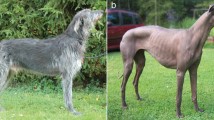Abstract
The scant hair mutant mouse (locus symbol: snthr 1Bao) is a recessive mutation that originated in an ethylnitrosourea chemical carcinogenesis study using the DBA/2J inbred strain. The gene responsible for the mutation was previously determined to be phospholipase C, delta 1 (Plcd1; mutant allele symbol Plcd1 snthr1Bao). To map the modifiers of Plcd1, an intercross (DBA/2J-snthr 1Bao/snthr 1Bao × C57BL/6J+/+) was conducted. The F2 mutant progeny exhibited a variety of alopecia phenotypes; all F2 mutants (n=507) were classified into 3 groups (mild, moderate, and severe alopecia) and genotyped based on 96 microsatellites. A major QTL was identified on mouse chromosome (mChr) 15 at 12 cM with an LOD score greater than 7 (P < 0.0001). Three minor QTLs were detected on mChr 2, 5, and 7 at 40, 84 and 48 cM, respectively. The QTLs on mChr 7 and 15 were associated with minor alopecia while the QTLs on mChr 2 and 5 were associated with moderate to severe alopecia. No antagonistic or synergistic effects among or between the 4 QTLs were found. Integrating the functions of the 4 potential regulatory QTLs and mutant Plcd1 snthr1Bao, we found that these QTLs might contribute to variations of scant hair severity by altering the Ca2+ signal pathways in mouse skin.
Similar content being viewed by others
References
Sundberg J P, Beamer W G, Uno H, et al. Androgenetic alopecia: In vivo models. Exp Mol Pathol, 1999, 67: 118–129
McElwee K, Boggess D, Miller J, et al. Spontaneous alopecia areata-like hair loss in one congenic and seven inbred laboratory mouse strains. J Invest Dermatol Symp Proc, 1999, 4: 202–206
Sundberg J P, Boggess D, Silva K A, et al. Major locus on mouse chromosome 17 and minor locus on chromosome 9 are linked with alopecia areata in C3H/HeJ mice. J Invest Dermatol, 2003, 120: 771–775
Stoll M, Kwitek-Black A, Cowley A W Jr, et al. New target regions for human hypertension via comparative genomics. Genome Res, 2000, 10: 473–482
Mao L, Zheng W J. Combining comparative genomics with de novo motif discovery to identify human transcription factor DNA-binding motifs. BMC Bioinformatics, 2006, 7(Suppl 4): S21
Peters L L, Robledo R F, Bult C J, et al. The mice as a model for human biology: A resource guide for complex trait analysis. Nat Rev Genet, 2007, 8: 58–69
Wu B J, Shao Y X, Mao H H, et al. Two kinds of ENU-induced scant hair mice and chromosome locations of the mutant genes. J Dermatol Sci, 2004, 36: 149–156
Wu B J, Mao H H, Zeng Y M, et al. Fine mapping and identifying the mutation gene of snthr -1Bao scant hair mouse (in Chinese). Zool Res, 2009, 10: 267–275
Tang L, Cao L, Sundberg J P, et al. Restoration of hair growth in mice with an alopecia areata-like disease using topical anthralin. Exp Dermatol, 2004, 13: 5–10
Joseph S, Russell D W. Molecular Cloning. A Laboratory Manual 3rd ed. (in Chinese). Beijing: Science Press, 2002
Sen S, Churchill G A. A statistical framework for quantitative trait mapping. Genetics, 2001, 159: 371–387
Doerge R W, Churchill G A. Permutation tests for multiple loci affecting a quantitative character. Genetics, 1996, 142: 285–294
Lander E, Kruglyak L. Genetic dissection of complex traits: Guidelines for interpreting and reporting linkage results. Nat Genet, 1995, 11: 241–247
Broman K W, Wu H, Sen S, et al. R/qtl: QTL mapping in experimental crosses. Bioinformatics, 2003, 19: 889–890
Su C F, Lu W G, Zhao T J, et al. Verification and fine-mapping of QTLs conferring days to flowering in soybean using residual heterozygous lines. Chinese Sci Bull, 2010, 55: 499–508
Wang X, Paigen B. Quantitative trait loci and candidate genes regulating HDL cholesterol: A murine chromosome map. Arterioscler Thromb Vasc Biol, 2002, 22: 1390–1401
Lyons M A, Wittenburg H, Li R, et al. Quantitative trait loci that determine lipoprotein cholesterol levels in DBA/2J and CAST/Ei inbred mice. J Lipid Res, 2003, 44: 953–967
Wang X, Le Roy I, Nicodeme E, et al. Using advanced intercross lines for high-resolution mapping of HDL cholesterol quantitative trait loci. Genome Res, 2003, 13: 1654–1664
Korstanje R, Li R, Howard T, et al. Influence of sex and diet on quantitative trait loci for HDL cholesterol levels in an SM/J by NZB/BlNJ intercross population. J Lipid Res, 2004, 45: 881–888
Wang X, Paigen B. Genome-wide search for new genes controlling plasma lipid concentrations in mice and humans. Curr Opin Lipidol, 2005, 16: 127–137
Sugiyama F, Churchill G A, Higgins D C, et al. Concordance of murine quantitative trait loci for salt-induced hypertension with rat and human loci. Genomics, 2001, 71: 70–77
Sundberg J P, Silva K A, Li R, et al. Adult onset alopecia areata is a complex polygenic trait in the C3H/HeJ mouse model. J Invest Dermatol, 2004, 123: 294–297
Ichinohe M, Nakamura Y, Sai K, et al. Lack of phospholipase C-delta1 induces skin inflammation. Biochem Biophys Res Commun, 2007, 356: 912–918
Chen J S, Xu D Q, De R Q. Trichology. Beijing: Beijing Science and Technology Press, 2004
Majumder P P, Ghosh S. Mapping quantitative trait loci in humans: Achievements and limitations. J Clin Invest, 2005, 115: 1419–1424
Author information
Authors and Affiliations
Corresponding authors
About this article
Cite this article
Wu, B., Zeng, Y., Mao, H. et al. Mapping of genetic modifiers of Plcd1 in scant hair mice (snthr 1Bao). Chin. Sci. Bull. 55, 4026–4031 (2010). https://doi.org/10.1007/s11434-010-4075-6
Received:
Accepted:
Published:
Issue Date:
DOI: https://doi.org/10.1007/s11434-010-4075-6




